The Sky This Month Sep-Oct 2019
The gas giants—Jupiter, Saturn, Neptune, and Uranus—are on display in evenings for the next few weeks. There are a number of interesting eclipse, transit, and shadow transit events at Jupiter. Neptune is at opposition so it is a great time to spot the very distant moon Triton. Also try for Oberon and Titania at Uranus. We highlight a variety of deep sky targets in Pegasus, Equuleus, Delphinus, Vulpecula, and Cepheus.
preamble
Blake Nancarrow delivered the following The Sky This Month presentation at the 11 September 2019 Recreational Astronomy Night meeting at the Ontario Science Centre. He prepared his usual month-at-a-glance calendar covering the balance of September and the first week of October 2019. You may view or download and print the colour calendar PDF file. ![]() TSTM 1909 calendar PDF
TSTM 1909 calendar PDF
All these materials accompany the recorded video. The unedited raw video is available for review. Blake's talk starts at the 9:29 mark and concludes at 51:32.
Update: the edited video is available on the RASC YouTube channel.
All photos and graphics copyright the respective owners.
If you are working on a RASC observing programme (perhaps to achieve a certificate), we include targets from Explore The Universe, Explore the Moon, Messier, and the RASC Finest NGCs. See https://rasc.ca/certificate-programs for more information. We also refer to Herschel 400, Halton Arp, and Caldwell objects. Many details of objects and events and phenomena are noted in the RASC Observer's Handbook.
observing lists
The suggested targets for this TSTM were collated into observing lists for a couple astronomy software apps with planning capabilities. You may download a file and install it in your device or computer so to have a list of suggestions when at the telescope or otherwise outside.
- SkySafari: TSTM1909.skylist, 6 KB, text
- SkyTools: TSTM1909.stx, 1 KB, binary
- Excel: TSTM1909.xls, 47 KB, binary
Note: Files stored on Blake's web site under the Computer Ease domain.
solar power
Our Sun might look like a ripe orange in a tinted full spectrum solar filter. In general it is spotless. We are in a very weak solar minimum phase as Frank Dempsey described a couple weeks ago. The Sun varies in activity according to a 7 to 11 year cycle. This means if you examine the Sun with a properly filtered telescope in white light right now, you will likely see a featureless disc. However, in the next few years, we should see our local star become active again.
That said, we are still observing periodic interactions with our magnetosphere and atmosphere with occasional aurora. A number of reports were made on the 2019 Labour Day weekend, from the Blue Mountains area as well as the Haliburtons.
Use the CalSky web site for planning, flyover predictions, and to receive alerts by email. https://calsky.com/
Have you seen the Northern Lights ever? Visit https://spaceweather.com/ for up-to-date information on the Sun.
The Sun is in constellation Leo and will enter Virgo on 17 Sep.
The times below are for Toronto area but are approximate. Your local time in Ontario may vary by a couple of minutes.
| date | sunset | twilight ends | twilight begins | sunrise | night hours |
|---|---|---|---|---|---|
| 11 Sep | 19:38 | 21:14 | 05:14 | 06:50 | 11.2 |
| 9 Oct | 18:47 | 20:20 | 05:50 | 07:23 | 12.6 |
Did you notice? The night hours between the two dates? Did you catch it? In this period, over the next couple of weeks, the night becomes longer than the day. The night time, between sunset and sunrise, becomes longer than 12 hours! Why? Because we will pass equinox date.
equality
In mid-June, the Earth is in a place in the orbit around the Sun such that the inclination of the planet's polar axis favours the northern hemisphere. The Earth's tilt is about 23 degrees. That tilt means longer days for locations above the equator, and the Sun higher in the sky, making for stronger day-time heating. Hence, the summer season.
But six months later, on the other side of the Sun, now the 23 degree tilt means the the northern hemisphere is angled away from the Sun. Shorter days, the Sun angle is lower, not as much heat is generated in the atmosphere. Winter in the north part of the planet; but summer in the south!
The mid-way point in the orbit, the equinox, either in September or March, means equal time for the day and night, and an averaging out of the effects of solar heating.
The next equinox on 23 Sep 2019.
The author is not a big fan of winter but the long dark nights (good for astronomy) make it more tolerable.
interplay
A half-lit Moon is arguably most interesting for the the interplay of light and dark, sunlight and shadow, along the terminator "line" on the lunar surface makes for a breathtaking view.
The Orrery by Joseph Wright of Derby is a wonderful artistic example of the "Chiaroscuro" or "clair-obscure" effect, the intermingling of light and dark.
https://en.wikipedia.org/wiki/Chiaroscuro
We can enjoy this effect any time with a solitary light source and the stark shadows created, say as we sit around a campfire at night.
Astronomy offers many instances to see this. Solar system objects, planet spheres, round or oblate moons, potato-shaped or snowman-shaped asteroids, lit by the distant Sun all show this. Our Moon particularly so, near first quarter or third quarter phase.
The main Moon phases for the next 4 weeks:
- full - 14 Sep 2019
- 3rd quarter - 21 Sep
- new Moon - 29 Sep
- 1st quarter - 4 Oct
During a full Moon, you can’t observe any interesting shadows but you can still see shade and colour in maria and in crater floors and enjoy bright impact rays. Many will be able to take in the brilliant full Moon during the Dunlap Institute planet-gazing party.
A unique clair-obscure effect on the Moon is Lunar X. The next opportunity should happen on Sat 5 Oct. In fact, this is the last Lunar X chance for 2019. West of Mare Nectaris, between craters Ptolemaeus and Tycho, there is a small set of craters, when lit at a steep angle, create the impression of a letter X floating in the dark. The feature is small so you'll need magnification.
Note: The basin and two craters are targets in the ETU program.
Also note that Saturn is 1 degree away on 5 Oct!
A few other notable lunar things:
- The Harvest Moon occurs at sunset on 13 Sep. Chris Vaughan, in his 8 Sep SkyLights, describes it well: "Because this is the closest full moon to the autumnal equinox in 2019, it is also [called] the Harvest Moon."
- The smallest full Moon of the year occurs this month. Will that get any headlines, the unsuper Moon, the super unMoon? The inferior Moon? Probably not. Hey, why don't you take a photo of the full Moon at apogee. And when the next perigee full Moon happens, take another photo, with the exact same set-up. Then you'll be able to see for yourself the relatively small difference in size.
- The new Moon will be near perigee, relatively close to the Earth. As it has happened for millions of years.
- Finally, the Moon will be near Pleiades and Hyades next week. That's cool to view in binoculars, our neighbour blocking out stars in an open cluster.
toward the Sun
The image shows planets near the Sun as of 11 Sep 2019 as if you're flying about in a spaceship a little above the Earth. You can see the Earth in the foreground and the Sun "ahead" of the Earth. Note Mercury, Venus, and Mars in the background. This illustrates a bit of bad news if you're trying to spot those planets: they'll be lost in the intense glare of our star.
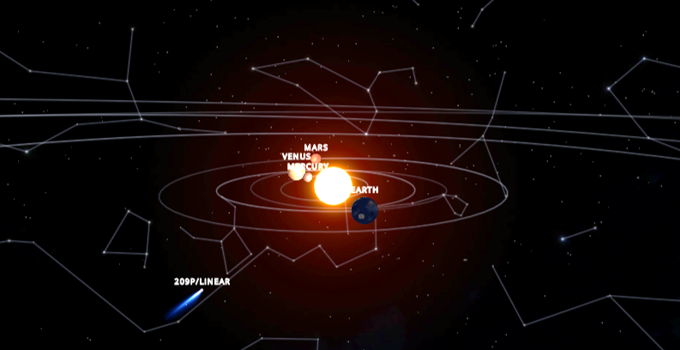
Remember, things left of the Sun are evening planets; things right would appear in the morning.
Mercury, Venus, Mars are almost in-line with Sun. When you get a straight line between the Earth, Sun, and planet, it's called a conjunction. With the inner planets, there are two types: inferior or superior. If Mercury or Venus is between us and the Sun, it's inferior.
Remember, everything (in generally) is moving counter-clockwise (from the north pole).
Also bear in mind the inner planets move faster. Mercury and Venus are moving to the left which puts them in the evening sky at sunset but they are terribly close to the Sun. On 11 Sep, they are about 7 degrees away—too risky to view with binoculars or a telescope. That gap is widening but they will likely be too hard to see. As well, Mercury is below the path of the planets (ecliptic) further complicating things.
Mars, opposite the Sun, was at conjunction last week and that means it is as far away from Earth as it can get. That also means the Red Planet is now moving away from the Sun. To be precise, it is us, the Earth, moving around the Sun faster. So it is our change in position that exposes Mars. Mars seems to be moving further to the right and becoming morning planet. By the end of this period, it will be 13 degrees from Sun. But don't get your hopes up. At a distance of over 2 astronomical units it will be very dim.
By the way, Mars is going through it's own solstice on 8 Oct for the same reason that we experience seasons. Axial tilt or inclination from the plane of the solar system creates seasons.
Quick quiz: Do you know the axial angle for the 3rd and 4th planets? See above for a hint for our home world.
To be precise: Earth is 23.4°; Mars is 25.2.
Of course the Sun and planets are all targets on the ETU.
gas giant show!
If we look at the big picture again but face the other direction, examining the outer planets, we see Jupiter, Saturn, Neptune, and Uranus. This simulates our late-night evening views.
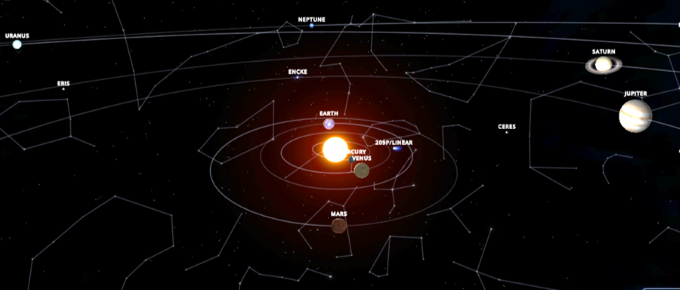
Jupiter, big and bright, leads the way. It sets early or first. So plan to check it out early in your sessions. The 5th planet appears to be between Scorpius and Ophiuchus. It is the brightest planet to the unaided eye right now.
Saturn was in "opposition" in the summer. It resides in Sagittarius. The rings are still tilted at a steep angle providing wonderful views. If you have high magnification and clear seeing conditions (steady air), look for the shadow of the planet on the background part of the rings!
Opposition is another important alignment of solar system bodies. When a planet is opposite the Sun from the Earth, if we draw a straight line through the Sun, Earth, and target, that puts the planet closest to us. That means opposition is the best time to see surface details, ring system features, and and spot elusive moons.
What do you notice about Neptune? It is clearly near opposition. In fact, it was yesterday (10 Sep 2019). The 8th planet is our system is in Aquarius. By the way, Galle's discovery of Neptune was in 1846 was on 23 Sep.
Uranus concludes the evening programme. It's in Aries. We're getting closer to it day by day. The aquamarine coloured world offers a number of moons visible in amateur telescopes. Did you know that Uranus can be seen with the unaided eye? It's not easy but certainly possible in the right conditions.
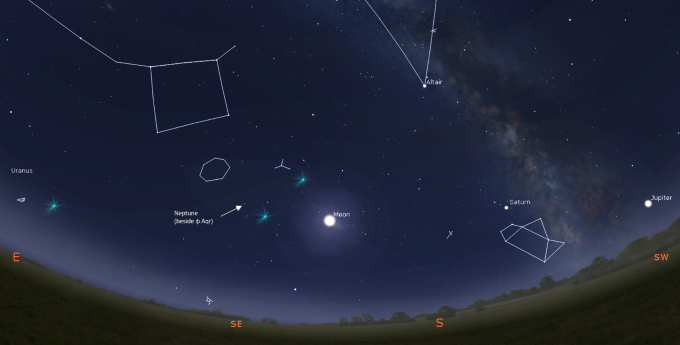
The perspective from Earth is intriguing with the gas giants across the whole sky, a wonderful panoramic view. Jupiter in the south-west, Saturn above Teapot, Neptune between and below Circlet and Water Jar, and Uranus to the east. On 11 Sep, the Moon is in the middle seat. Of course, it will return a month later...
Jupiter special events
The calendar provided documents many Jupiter "events," some with an exclamation point. These are eclipses, occultations, transits, shadow transits, Great Red Spot meridian crossings, etc. Often the calendar notes when there are two things occurring at the same time. These are a lot of fun to watch...
We showcase here one type of a special Jupiter "event". Note there are only 3 of the Galilean moons showing in the image below. Where is Io? Get ready… On Sat 28 Sep 2019, around 9:00 PM, something neat will happen. Be ready a few minutes before. In fact, be trained on Jupiter, focused, enjoying the view, be good and settled.
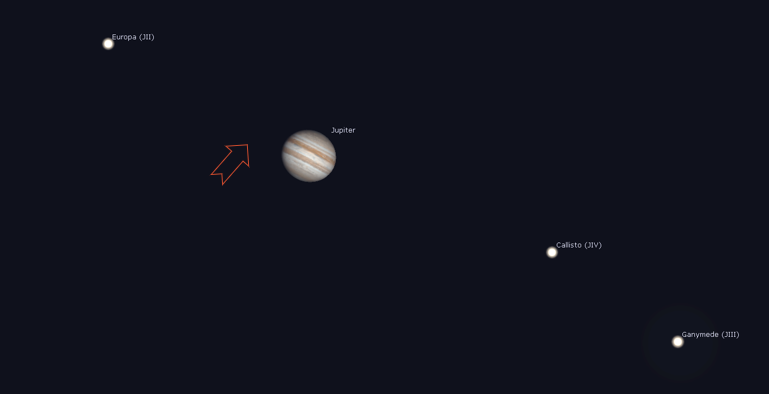
Note the arrow pointing to an empty space on the left (east) side of Jupiter. And that arrow is some distance away, almost one planet diameter away. This is the same side Europa appears, a single moon, while Callisto and Ganymede are obvious on the west side.
Around 9:01 or 9:02, a new point of light should suddenly pop into view. Boom, there it is! Do you know what happened?
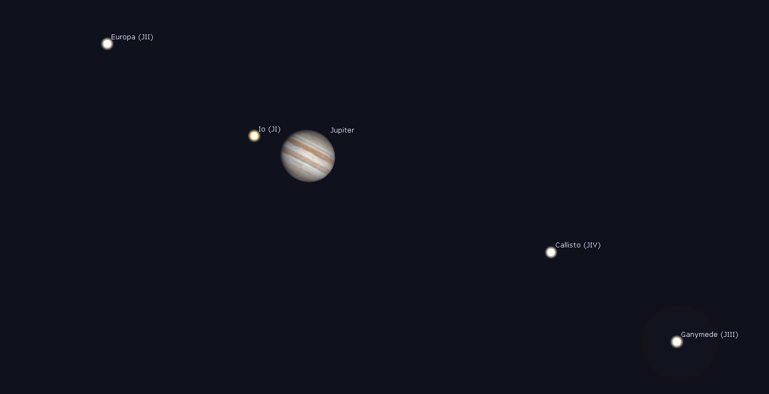
Suddenly Io appears, well away from Jupiter. Clearly it was not "behind" Jupiter, i.e. behind the disc of the planet, emerging or peeking from behind the bright big disc. That's an occultation event, when Jupiter covers a moon. The 28 Sep event is an "eclipse". Io was orbiting around the Jovian world, as per usual, counterclockwise from the top, but it was in the deep large shadow produced by Jupiter. The sunlight was blocked by the big planet. It is as if Jupiter punches a big hole of darkness beyond the planet. This prevented the sunlight from hitting or reaching the moon. But then Io moved out of the large shadow cone and popped into the sunlight. This exciting observation shows you that all those little worlds are moving pretty quickly. Imagine the wonder Galileo felt seeing this dynamic phenomena for the first time.
Quick quiz: Which Galilean moons bigger or smaller than our Moon?
The answer is that all are bigger except for Europa.
Neptune special events
Again, periods around planetary oppositions are excellent for looking for things on the planet or with the moons. It is a very good time to look at Neptune. Have you seen Neptune in the telescope? What about binoculars?! Yes, it is possible with binoculars, if you know where to look. When it is near an obvious star, that helps a little in finding and identifying it. The deep blue world is very near the star phi Aquarii, slowly moving away from it.
With a magnitude of approximately 7.8, it is below our ability to spot naked eye. Neptune's distance is 29 astronomical units (AU). The AU measure is the distance between the Sun and Earth. So Neptune is nearly 30 times that distance. That's 4.3 billion kilometres! Or to put it another way, that’s over 4 hours of light travel time!
By comparison, Uranus is only 18 AU from Earth. The calendar also notes Uranian moon events. Have you seen Oberon and Titania? Ariel remains unseen by the author.
Even though Neptune and Uranus are close during oppositions, they are still so small that we, with our amateur telescopes, cannot see any detail in the clouds. Leave that to the Hubble Space Telescope.
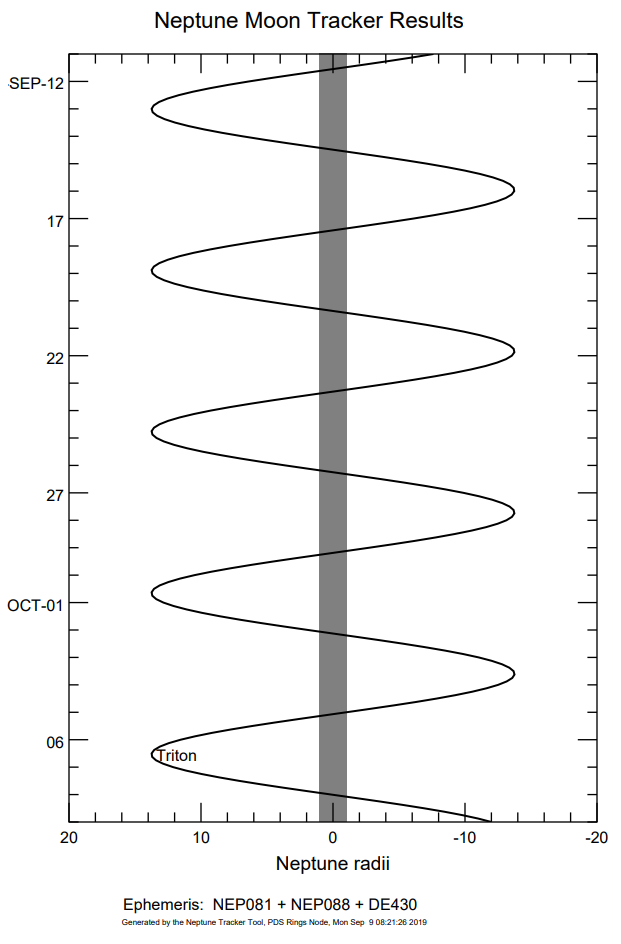
Neptune has many moons including the seventh-largest moon in the solar system. Have you spotted Triton? Life-list item! The amazing thing about this distant moon is that a combination of its size and reflectivity (albedo) allow it to be seen in amateur (albeit large) telescopes. The best times to tag Triton are during elongations, when the moon swings out far for the host planet. There do not seem to be a lot of convenient times, at least for maximum elongation, but if you’ve not seen it, you gotta try whenever you're out under the stars. For example, there’s a southern elongation at 0241h EDT on 16 Sep 2019.
Try the Neptune Moon Tracker tool to plot a helpful sinusoidal chart.
https://pds-rings.seti.org/tools/tracker2_nep.html
Fact: The discovery of Triton was made on 10 October 1846 by English astronomer William Lassell.
It's time to go further out...
beyond the solar system
For this The Sky This Month, we have selected constellations near or on the meridian during evening times. This puts the stars and celestial objects up high. The higher the better for faint objects like galaxies, nebulae, and globular clusters.
The meridian is an imaginary line that runs from north through south, overhead, above the observer or through the zenith. Software apps can display the meridian to give you a sense of how high things are. Or, if imaging, when you may need to plan for a meridian flip.
The Winged Horse
Pegasus is high overhead. The constellation is big with many interesting objects.
For stars, we have a couple of suggestions.
Σ2958. This is a tight double star at 3.9 seconds of arc. The magnitude delta or difference is 2.4. So slightly challenging but a satisfying type of double system. With a colourful primary and a very orange or red secondary. Quite lovely. Easy in small telescope at 110x.
IK Peg aka HR 8210. This is a somewhat dim, yellow, variable star. Nothing special... But Dr Phil Plait, back in 2012, described it as a "weird" star, a potential outburst star. He explained that the primary component is not big enough to explode but white dwarf companion, accreting material at a furious rate from the main star, may blow up in a most spectacular way. At 150 light years, we're out of the danger zone. Whew! Consider regularly "monitoring" this star for any unusual and sudden changes in brightness.
51 Pegasi. This is a Sun-like star located 50 ly away. It is the first main-sequence star found to have an exoplanet. That distant planet has been officially designated 51 Peg b or Dimidium. While we can't see the exoplanet in an amateur telescope, that's a fun one to show and talk about at star parties.
For deep sky objects, i.e. non-stellar targets, we have a range of DSOs for your consideration.
Take in the globular cluster M15 or Messier 15. Not far from Enif. The distant glob has a planetary nebula (Ps 1) within it! But it is magnitude 14.9...
NGC 7331 is a medium-sized galaxy and one of the targets on the RASC Finest NGC list. Also known as Caldwell 30. It is a lovely canted spiral galaxy revealing amazing structure.
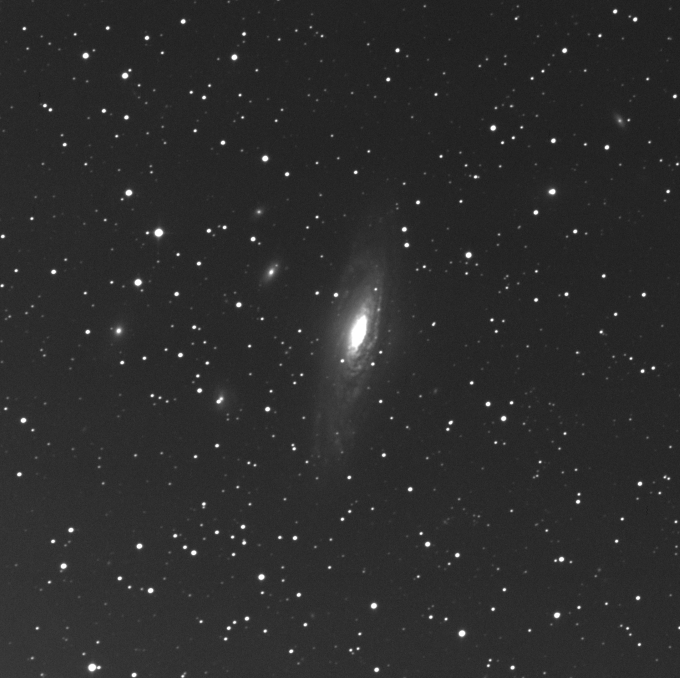
Do you see the neighbouring galaxies? 7331 is part of the Deer Lick Group with other smaller members including NGC 7326, 7335, 7336, 7337, and 7340.
It is not far from another interesting galaxy group, Stephan's Quintet.
A Herschel 400 galaxy in Pegasus is NGC 7217.
A challenge target is Arp 278. This subject offers two in the view with NGC 7253A and NGC 7253B. These are small interacting galaxies. The author's view with averted vision was indeterminate and very soft in a 14-inch instrument. Full dark adaptation is required. They are obvious in astroimages.
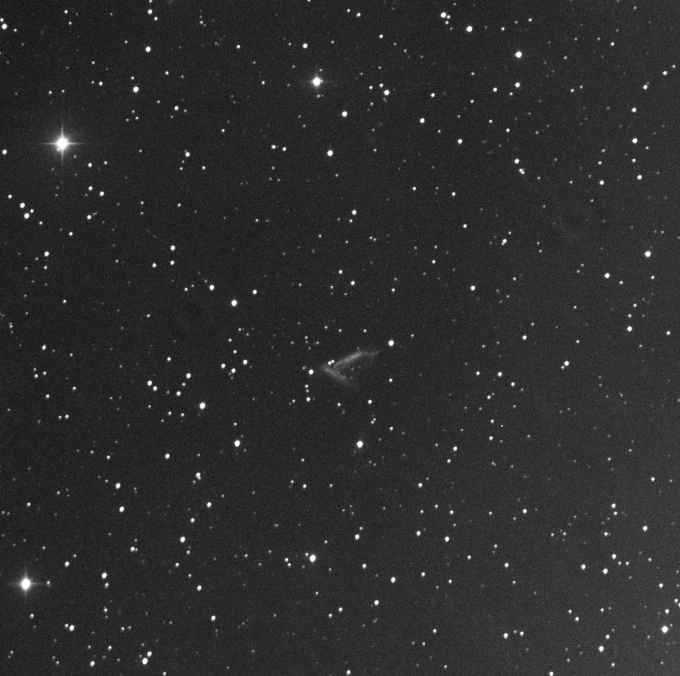
A is to the north, oriented south-east to north-west.
Comet C/2018 W2 Africano zips through the eastern corner of Pegasus at the end of September. As of 9 Sep 2019, it is 10.1 mag. It is expected to brighten up to mag 8 or 9, which frankly is still faint. Is it visible in binoculars? Or one of the imagers?
Use https://cometchasing.skyhound.com/ and http://aerith.net/ for up-to-date comet predictions.
little constellations
There are a few small constellations near the Summer Triangle, all touching, some with its silly stick figures. They feature a little fox, an arrow loosed, more horses, and a dolphin.
We start with some binocular candidates.

View α (alpha) Vulpeculae at very low power. aka Σ Appendix A 42. Named Anser, this is a bright light gold primary with hints of orange. The author's log note shows "yellow star to the north as the companion." Well away and also fairly bright. But in the photo, B seems light blue or blue-white. Also note A is known as 6 Vul and B, 8 Vul.
Keep those binoculars handy. Nearby is the obvious Coathanger cluster. aka Collinder 399 and Brocchi's Cluster. In a fairly dark sky this is actually attainable with the unaided eye.
Now, fire up the telescope.
At high power near Anser lies a colourful multi-star system with the prosaic moniker POU 3855. The main star is pale orange. The B star to the north-west is a deep orange, almost red. And the C companion opposite, south-east, is hard to tag. Could it be purple?! It can't be. Is it blue? Is it orange? Is it grey? You be the judge.
β (beta) Delphini aka Rotanev is in the neck of the leaping water mammal. It is compelling quadruple. AB: fast-moving binary with a 27 year period. Wide when Sissy Haas documented this pair (in 2006). Software calculated the split at 0.26" for May 2015. The author has never split the pale yellow point. AC: 18.7", very faint compared to A. Very close at low power! AD: 44.3", easily spotted. Blue.
There are other colourful doubles in Deliphinus.
ε (epsilon) Equulei aka Σ2737 or 1 Equ. Another attractive but frustrating multi-star system. The AB pair probably is too tight for most. The Observer's Handbook shows them very close together. AC: 10.5", easily split. Bright yellow and light yellow. Hints of green? Different magnitudes. While, AD, at 74.8 arc-seconds was trivial while rather faint. Widely separated.
The Dumbbell is big planetary nebula. Another Messier catalogue item, taking the 27th position. Some call it the "apple core." Responds to filters. Wonderful to photograph. The dual lobed object is 975 light-years away.
If ticking off another checkbox, globular Messier 71 is near the middle of the archer's arrow. It is mixed in with Milky Way stars from our perspective. Is it across the galaxy like many globulars? No, it's relatively close. A most intriguing thing is that M71 is located within the disc of the Milky Way! That's a little unusual.
Just east of the Coathanger is a Finest NGC, number 6802, aka Cr 400, and OCL 114. This is a small compact open cluster. At low power it resolves as a fuzzy between some equally spaced pairs of stars. Fainter than NGC 6819 at mag 11.7.
NGC 6934 aka Caldwell 47 is a nice, small round globular cluster in Delphinus. There was a neat line of stars nearby. It is a Herschel 400 target too.
Remember, you can capture CCD images for free with BGO at SMU.
hail the king
Let us visit Cepheus in the north. It is near the meridian (and above the North Celestial Pole).
Here's a fun activity that requires Mark I (or Mark II) eyeballs. View δ (delta) Cephei and compare it to zeta and epsilon. Which is it closest to in intensity? Note the exact date and time for an easy peasy variable star brightness assessment. It varies between magnitude 3.5 and 4.4 over 5.4 days. δ Cep is prototypical variable star, an important step in the cosmic ladder used to measure distances, both intra- and extra-galactic.
Nearby is another interesting star. The Garnet Star, mu Cephei, is variable too, 3.4 to 5.1, over 2 years. Some describe it as a "red" star; it always looks orange to the author. Spot it naked eye or view in binoculars. If using a telescope, keep to low power. That draws in other nearby stars so to help you gauge the colour.
Put telescopic magnification on this star and you'll discover many nearby points of light in a multi-star system.
There's interesting stuff going on over at the Cepheus-Cygnus border, where the little finger sticks up.
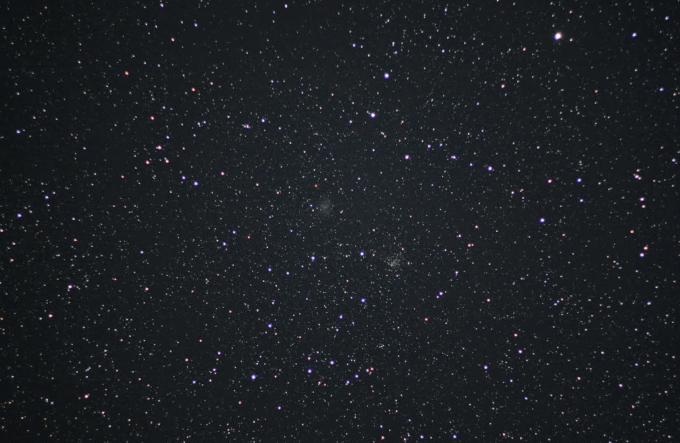
Here you'll find NGC 6946, the Fireworks Galaxy. It is considered one of the RASC 40 Brightest galaxies which is curious given it's face-on orientation and low surface brightness. Regardless, it is a Finest NGC, a Herschel 400, an Arp item (29), and a Caldwell (12). You just ticked a whole bunch of check boxes on that one. The object is huge at 78x! Oval shape, oblong, mottled. When the view is steady and clear, it shows as a fantastic spiral. The author imaged this large galaxy a dozen times while following the dimming of the supernova SN2017eaw through 2017. Right beside the Fireworks is more fireworks. NGC 6939 is another Finest NGC and Herschel 400. But this time you'll find a large, loose open cluster. About the same size as nearby galaxy. Maybe a little larger.
Stellarium sure has some interesting names for other objects in the area:
- Swimming Alligator Cluster
- The Wizard Nebula
- The Dormouse Cluster
- Silk Fan Cluster
low but bright
One more target. An interesting fun one that does not require special equipment. Look for Fomalhaut or α Piscis Austrini. The star name means the "fish's mouth" in Arabic. This is one of the brightest stars in the sky, nearly due south at midnight, and quite possibly visible through the light-pollution of city skies. That's partly due to distance: it is approximately 25 light-years away.
The third-brightest star in the sky is known to have a planetary system, designated Fomalhaut b or Dagon. It holds a special significance in extrasolar planet research being the first stellar system with an extrasolar planet candidate imaged at visible wavelengths. Once again, it is neat pointing things like this out at star parties or for friends and family, easy-to-spot stars, saying, "We know that has exoplanets."
Remember: Stellarium for Windows and Mac computers is free!
miscellaneous
There do not seem to be any asteroid occultations of note. Certainly there are many events but none right over Toronto with bright stars and high ranks. For example, the Shantou occultation runs from London to Hamilton. It has bright stars and a long blink but the rank is 60%.
See http://www.asteroidoccultation.com/ for more information.
If you want to observe a pinpoint shifting position slowly, look for Ceres near the bright orange star of Antares in Scorpius. Ceres used to be catalogued as an asteroid; now it is classified a dwarf planet.
Happy palindromes!
spaceflight news
The James Webb Space Telescope is heading into integrated trials, that is, testing with all the major components connected to one another.
JAXA, the Japanese space agency, is sending another HTV cargo ship uphill to International Space Station. UPDATE: the launch attempt on Tue 10 Sep 2019 was scrubbed. New date TBA.
Boeing may launch their Starliner craft in the next few weeks. They are one of the companies in the USA promising to carry humans off the planet.
Evening flyovers of the ISS start up again on Tue 17 Sep. There are two particularly bright ones predicted for Sat 5 Oct and Sun 6 Oct.
Crew members on a Soyuz are launching to ISS on Wed 25 Sep. This might offer us a chance to see a dual pass, i.e. two points of light in close proximity tracking rapidly across the sky.
There are a few fun anniversaries...
Canada's Alouette 1 satellite blasted off back on 28 Sep 1962. While now deactivated, it studied the ionosphere. It was the first satellite constructed by a country other than the Soviet Union or the United States and made Canada the fourth country to operate a satellite. The name came from the French for "skylark" and the French-Canadian folk song of the same name.
NASA's birthday is 1 Oct 1958.
And Sputnik, what started it all, was launched 4 Oct 1957.
Use https://spaceflightnow.com/ to stay up to date.
planning ahead
So, prep those observing lists. Lots going on the next few weeks of Sep-Oct 2019.
- multiple Jupiter events
- GRS, transit, shadow! on Jupiter Fri 27 Sep
- Io pops on Sat 28 Sep
- tag Jupiter in the daylight near Moon Thu 3 Oct
- stunning Saturn continues to please
- enjoy the Neptune opposition
- spot Triton
- get ready for Uranus planet and moon sightings
- lots of Moon related-stuff happening on Sat 5 Oct
- comet Africano brightens and moves rapidly southward
- nights longer than 12 hours begin Mon 23 Sep
- dual flyover Wed 25 Sep?!
- view double stars, variable stars, exoplanet host stars, planetary nebula, open clusters, globular clusters, galaxies, galaxy groups in the constellations Cepheus, Delphinus, Equuleus, Pisces Austrinus, Sagitta, and Vulpecula
conclusion
Lots of thanks are due. Tools used to compile information and make info-graphics include SkyTools, Stellarium, SkySafari, OccultWatcher, SolarSystemScope, and Paint.NET. Many images were produced with BGO at SMU. Ian Wheelband enabled the piggyback image. Thanks to Betty, Andrew, and Ward for video streaming and recording. The QR code was quickly produced with www.qr-code-generator.com. Much data was copied from David Mitsky's monthly report. Facts and figures from the amazing wikipedia. Noted some interesting things in Chris Vaughan's report at his AstroGeo website. The monthly report from SkyMaps.org was consulted.
See the author's blog at http://blog.lumpydarkness.com/ for astronomy information, astrophotos, tips and tricks, guides and videos on astronomy software, and so on.
Contact Blake Nancarrow (astronomy at computer-ease dot com) for errors, omissions, questions.
Be seeing you.
Blake

